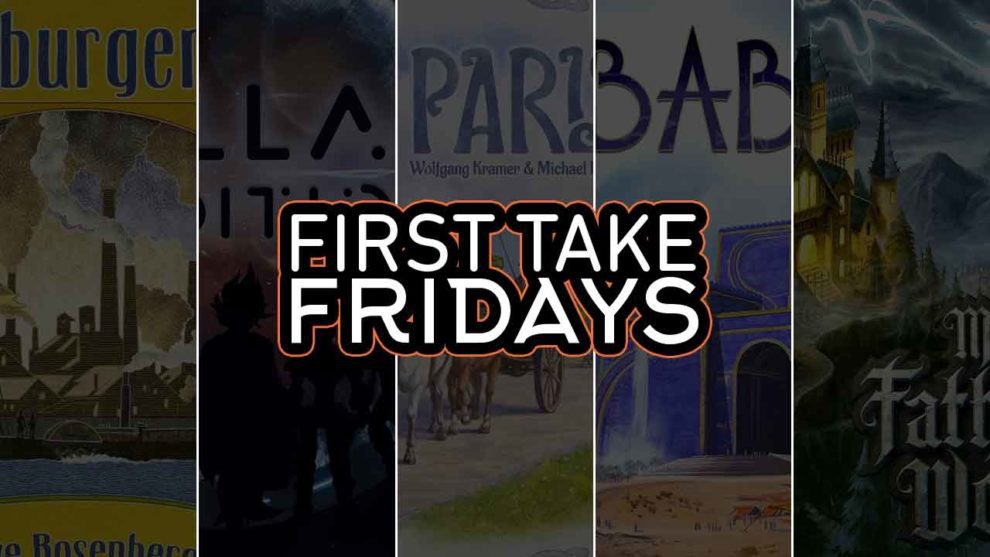Oranienburger Kanal – David McMillan
Oranienburger Kanal was easily my most anticipated game from 2022. After what’s felt like literal decades, but has actually only a few short months, it’s finally arrived on American shores and, more importantly, my doorstep. I wasted no time in getting it to the table.
Uwe Rosenberg’s latest creation is a 2-player worker placement, tableau/route builder about constructing the various industries that make the titular canal sing, and then connecting those industries together via different types of routes. Each industry, represented by a card, has a unique ability that can potentially fire off twice per game, once when it is surrounded by routes, and once when it is connected to neighboring industries by at least two bridges.
It’s a game all about efficiency, spatial management, planning and setting yourself up for the future, and resource management and, wow, is it a lot of fun. It’s super crunchy, too. I can’t wait to further explore Oranienburger Kanal’s hidden depths, and I especially can’t wait to try out some of the other card decks that came with my copy.
Watch out for my upcoming review.
Ease of entry?:
★★★☆☆ – There were a few questions
Would I play it again?:
★★★★★ – Will definitely play it again
Read more articles from David McMillan.
Stellar Expedition – David Wood
Stellar Expedition, is a 3X game of Exploration, Expansion, and Exploitation. Each player commands a starship exploring new locations, establishing embassies, and recruiting new crew members. Players can obtain upgrades to their ship, as well as damage from hazards they encounter along the way. Each crew member has a unique set of skills which can be used to complete expeditions. The player who accumulates the most expedition points by the end of the eighth round of the game is the winner.
Game play is straightforward, yet very satisfying. Some have likened Stellar Expedition to the TV series Star Trek because the emphasis is on peaceful exploration and creating a crew from diverse worlds. That said, players can attempt to block others from accomplishing their Expeditions. So, while there is no open conflict, all is not peace and love.
The artwork in this game is phenomenal, especially the crew cards. Every crew member is unique, not only in terms of their skills, but also the illustrations. In addition to the crew deck, there are decks for ship Upgrades, Expeditions, random Encounters, and each Location. The latter have a corresponding hexagonal tile which players will place during the Discovery phase to expand the game board. The game includes six optional expansion modules and a solo mode.
Ease of entry?:
★★★★☆ – The odd bump or two
Would I play it again?:
★★★★★ – Will definitely play it again
Read more articles from David Wood.
Paris – Bob Pazehoski, Jr.
I’ve not come across a game that feels quite like Paris. There was a moment relatively early in this first game where I had to search the book just one more time to see where the victory points were! Most points come from area management in the city’s eight sectors, achieved by controlling buildings and landmarks worth a variety of points. While there are minor blessings along the way, and a lot of interesting decisions, each sector yields its greatest value in the endgame. At first glance, I had to wonder just how it would all hold together, but I must say it’s rather fascinating.
The more compelling twist in the game arrives when the final Building tile comes into play. Just when the board is fully revealed, a whole new tension arises as players are given the option of claiming endgame tiles. Once this stack of a dozen or so French flags is empty, the game ends. The low-key pressure that results from this little mechanic is beyond interesting. I see now the importance of planning for the end and managing the passage of time. I have to play again just to learn this new rhythm. It’s like taking up a waltz…that shifts to a jitterbug on the final page of the sheet music.
Ease of entry?:
★★★★☆ – The odd bump or two
Would I play it again?:
★★★★★ – Will definitely play it again
Read more articles from Bob Pazehoski, Jr.
Babylonia – Andrew Lynch
Few words will get me to the table faster than “a new tile-layer designed by Reiner Knizia,” yet it would appear those words are not enough to get the game itself to the table. Babylonia has sat unplayed on my shelf for almost 18 months. The rules take a moment to go over, but the manual is concise and approachable. The game itself is simple and plays at a clip. One of the few times I’ve seen a playtime significantly overestimate the time spent playing. I could see Babylonia taking longer the more you play it, though. Neither as difficult to learn nor as punishing to lose as Tigris & Euphrates, Babylonia seems at first blush to be a rich, interactive, simple entry in Knizia’s canon. I’ve been thinking about it in the back of my mind for days now.
Ease of entry?:
★★★★☆ – The odd bump or two
Would I play it again?:
★★★★★ – Will definitely play it again
Read more articles from Andrew Lynch.
My Father’s Work – Tom Franklin
My Father’s Work ranks as the largest, heaviest game in my collection. With its high-end minis, slick GameTrayz inserts and three unique storylines, there’s no doubt the production values are some of the best I’ve seen in a long time. But how does the game itself hold up?
This is part worker-placement and part engine-builder, so the gameplay should be fairly familiar. What sets My Father’s Work apart from other games in this genre is the narrative behind each of the stories. That narrative changes based on the choices you and your fellow scientists are called upon to make throughout the game. It’s a fascinating way of approaching a game, and has been a big hit with my weekly group. In fact, they’ve asked that we just play My Father’s Work for the next few weeks to explore the different stories, something I am more than happy to do.
Look for my full review soon.
Watch our review of My Father’s Work.
Ease of entry?
★★★★☆ – The odd bump or two
Would I play it again?:
★★★★★ – Will definitely play it again












Add Comment